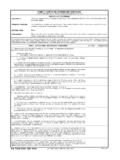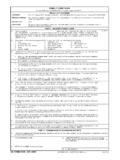Transcription of Xilinx DS160 Spartan-6 Family Overview
1 DS160 ( ) October 25, Specification1 2009 2011 Xilinx , Inc. Xilinx , the Xilinx logo, Artix, ISE, Kintex, spartan , Virtex, Zynq, and other designated brands included herein are trademarks of Xilinx in the United States and other countries. PCI, PCIe and PCI Express are trademarks of PCI-SIG and used under license. All other trademarks are the property of their respective DescriptionThe spartan -6 Family provides leading system integration capabilities with the lowest total cost for high-volume applications. The thirteen-member Family delivers expanded densities ranging from 3,840 to 147,443 logic cells, with half the power consumption of previous spartan families, and faster, more comprehensive connectivity. Built on a mature 45 nm low-power copper process technology that delivers the optimal balance of cost, power, and performance, the Spartan-6 Family offers a new, more efficient, dual-register 6-input look-up table (LUT) logic and a rich selection of built-in system-level blocks.
2 These include 18 Kb (2 x 9 Kb) block RAMs, second generation DSP48A1 slices, SDRAM memory controllers, enhanced mixed-mode clock management blocks, SelectIO technology, power-optimized high-speed serial transceiver blocks, PCI Express compatible Endpoint blocks, advanced system-level power management modes, auto-detect configuration options, and enhanced IP security with AES and Device DNA protection. These features provide a low-cost programmable alternative to custom ASIC products with unprecedented ease of use. Spartan-6 FPGAs offer the best solution for high-volume logic designs, consumer-oriented DSP designs, and cost-sensitive embedded applications. Spartan-6 FPGAs are the programmable silicon foundation for Targeted Design Platforms that deliver integrated software and hardware components that enable designers to focus on innovation as soon as their development cycle of Spartan-6 FPGA Features Spartan-6 Family : Spartan-6 LX FPGA: Logic optimized Spartan-6 LXT FPGA.
3 High-speed serial connectivity Designed for low cost Multiple efficient integrated blocks Optimized selection of I/O standards Staggered pads High-volume plastic wire-bonded packages Low static and dynamic power 45 nm process optimized for cost and low power Hibernate power-down mode for zero power Suspend mode maintains state and configuration with multi-pin wake-up, control enhancement Lower-power core voltage (LX FPGAs, -1L only) High performance core voltage (LX and LXT FPGAs, -2, -3, and -3N speed grades) Multi-voltage, multi-standard SelectIO interface banks Up to 1,080 Mb/s data transfer rate per differential I/O Selectable output drive, up to 24 mA per pin to I/O standards and protocols Low-cost HSTL and SSTL memory interfaces Hot swap compliance Adjustable I/O slew rates to improve signal integrity High-speed GTP serial transceivers in the LXT FPGAs Up to Gb/s High-speed interfaces including: Serial ATA, Aurora, 1G Ethernet, PCI Express, OBSAI, CPRI, EPON, GPON, DisplayPort, and XAUI Integrated Endpoint block for PCI Express designs (LXT) Low-cost PCI technology support compatible with the 33 MHz, 32- and 64-bit specification.
4 Efficient DSP48A1 slices High-performance arithmetic and signal processing Fast 18 x 18 multiplier and 48-bit accumulator Pipelining and cascading capability Pre-adder to assist filter applications Integrated Memory Controller blocks DDR, DDR2, DDR3, and LPDDR support Data rates up to 800 Mb/s ( Gb/s peak bandwidth) Multi-port bus structure with independent FIFO to reduce design timing issues Abundant logic resources with increased logic capacity Optional shift register or distributed RAM support Efficient 6-input LUTs improve performance and minimize power LUT with dual flip-flops for pipeline centric applications Block RAM with a wide range of granularity Fast block RAM with byte write enable 18 Kb blocks that can be optionally programmed as two independent 9 Kb block RAMs Clock Management Tile (CMT) for enhanced performance Low noise, flexible clocking Digital Clock Managers (DCMs) eliminate clock skew and duty cycle distortion Phase-Locked Loops (PLLs) for low-jitter clocking Frequency synthesis with simultaneous multiplication, division, and phase shifting Sixteen low-skew global clock networks Simplified configuration, supports low-cost standards 2-pin auto-detect configuration Broad third-party SPI (up to x4) and NOR flash support Feature rich Xilinx Platform Flash with JTAG MultiBoot support for remote upgrade with multiple bitstreams, using watchdog protection Enhanced security for design protection Unique Device DNA identifier for design authentication AES bitstream encryption in the larger devices Faster embedded processing with enhanced, low cost, MicroBlaze soft processor Industry-leading IP and reference designs11 Spartan-6 Family OverviewDS160 ( ) October 25, 2011 Product SpecificationSpartan-6 Family OverviewDS160 ( )
5 October 25, Specification2 Spartan-6 FPGA Feature SummaryTa b l e 1 : Spartan-6 FPGA Feature Summary by DeviceDeviceLogic Cells(1)Configurable Logic Blocks (CLBs)DSP48A1 Slices(3)Block RAM BlocksCMTs(5)Memory Controller Blocks (Max)(6)EndpointBlocks forPCI ExpressMaximum GTP TransceiversTo ta lI/OBanksMaxUser I/OSlices(2)Flip-FlopsMax Distributed RAM (Kb)18 Kb(4)Max (Kb)XC6 SLX43,8406004,8007581221620004132XC6 SLX99,1521,43011,44090163257622004200XC6 SLX1614,5792,27818,224136323257622004232 XC6 SLX2524,0513,75830,064229385293622004266 XC6 SLX4543,6616,82254,576401581162,08842004 358XC6 SLX7574,63711,66293,2966921321723,096640 06408XC6 SLX100101,26115,822126,5769761802684,824 64006480XC6 SLX150147,44323,038184,3041,3551802684,8 2464006576XC6 SLX25T24,0513,75830,06422938529362212425 0XC6 SLX45T43,6616,82254,576401581162,0884214 4296XC6 SLX75T74,63711,66293,2966921321723,09664 186348XC6 SLX100T101,26115,822126,5769761802684,82 464186498XC6 SLX150T147,44323,038184,3041,3551802684, 82464186540 Notes: FPGA logic cell ratings reflect the increased logic cell capability offered by the new 6-input LUT Spartan-6 FPGA slice contains four LUTs and eight DSP48A1 slice contains an 18 x 18 multiplier, an adder, and an RAMs are fundamentally 18 Kb in size.
6 Each block can also be used as two independent 9 Kb CMT contains two DCMs and one Controller Blocks are not supported in the -3N speed Family OverviewDS160 ( ) October 25, Specification3 Spartan-6 FPGA Device-Package Combinations and Available I/OsSpartan-6 FPGA package combinations with the available I/Os and GTP transceivers per package are shown in Ta b l e 2. Due to the transceivers, the LX and LXT pinouts are not FPGAs store the customized configuration data in SRAM-type internal latches. The number of configuration bits is between 3 Mb and 33 Mb depending on device size and user-design implementation options. The configuration storage is volatile and must be reloaded whenever the FPGA is powered up. This storage can also be reloaded at any time by pulling the PROGRAM_B pin Low. Several methods and data formats for loading configuration are configurations can be either master serial mode, where the FPGA generates the configuration clock (CCLK) signal, or slave serial mode, where the external configuration data source also clocks the FPGA.
7 For byte-wide configurations, master SelectMAP mode generates the CCLK signal while slave SelectMAP mode receives the CCLK signal for the 8- and 16-bit-wide transfer. In master serial mode, the beginning of the bitstream can optionally switch the clocking source to an external clock, which can be faster or more precise than the internal clock. The available JTAG pins use boundary-scan protocols to load bit-serial configuration b l e 2 : Spartan-6 Device-Package Combinations and Maximum Available I/OsPackageCPG196(1)TQG144(1)CSG225(2)FT (G)256(3)CSG324FG(G)484(3,4)CSG484(4)FG( G)676(3)FG(G)900(3)Body Size (mm)8x820x2013x1317x1715x1523x2319x1927x 2731x31 Pitch (mm) I/OUser I/OUser I/OUser I/OGTPsUser I/OGTPsUser I/OGTPsUser I/OGTPsUser I/OGTPsUser I/OXC6 SLX4106102132XC6 SLX9106102160186NA200XC6 SLX16106160186NA232XC6 SLX25186NA226NA266XC6 SLX45NA218NA316NA320NA358XC6 SLX75NA280NA328NA408XC6 SLX100NA326NA338NA480XC6 SLX150NA338NA338NA498NA576XC6 SLX25T21902250XC6 SLX45T419042964296XC6 SLX75T426842928348XC6 SLX100T4296429683768498XC6 SLX150T4296429683968540 Notes: is no memory controller on the devices in these controller block support is x8 on the XC6 SLX9 and XC6 SLX16 devices in the CSG225 package.
8 There is no memory controller in the devices are available in both Pb and Pb-free (additional G) packages as standard ordering packages support two of the four memory controllers in the XC6 SLX75, XC6 SLX75T, XC6 SLX100, XC6 SLX100T, XC6 SLX150, and XC6 SLX150T Family OverviewDS160 ( ) October 25, Specification4 The bitstream configuration information is generated by the ISE software using a program called BitGen. The configuration process typically executes the following sequence: Detects power-up (power-on reset) or PROGRAM_B when Low. Clears the whole configuration memory. Samples the mode pins to determine the configuration mode: master or slave, bit-serial or parallel. Loads the configuration data starting with the bus-width detection pattern followed by a synchronization word, checks for the proper device code, and ends with a cyclic redundancy check (CRC) of the complete bitstream. Starts a user-defined sequence of events: releasing the internal reset (or preset) of flip-flops, optionally waiting for the DCMs and/or PLLs to lock, activating the output drivers, and transitioning the DONE pin to Master Serial Peripheral Interface (SPI) and the Master Byte-wide Peripheral Interface (BPI) are two common methods used for configuring the FPGA.
9 The Spartan-6 FPGA configures itself from a directly attached industry-standard SPI serial flash PROM. The Spartan-6 FPGA can configure itself via BPI when connected to an industry-standard parallel NOR flash. Note that BPI configuration is not supported in the XC6 SLX4, XC6 SLX25, and XC6 SLX25T nor is BPI available when using Spartan-6 FPGAs in TQG144 and CPG196 FPGAs support MultiBoot configuration, where two or more FPGA configuration bitstreams can be stored in a single configuration source. The FPGA application controls which configuration to load next and when to load FPGAs also include a unique, factory-programmed Device DNA identifier that is useful for tracking purposes, anti-cloning designs, or IP protection. In the largest devices, bitstreams can be copy protected using AES configuration data can be read back without affecting the system s , Slices, and LUTsEach configurable logic block (CLB) in Spartan-6 FPGAs consists of two slices, arranged side-by-side as part of two vertical columns.
10 There are three types of CLB slices in the Spartan-6 architecture: SLICEM, SLICEL, and SLICEX. Each slice contains four LUTs, eight flip-flops, and miscellaneous logic. The LUTs are for general-purpose combinatorial and sequential logic support. Synthesis tools take advantage of these highly efficient logic, arithmetic, and memory features. Expert designers can also instantiate quarter (25%) of Spartan-6 FPGA slices are SLICEMs. Each of the four SLICEM LUTs can be configured as either a 6-input LUT with one output, or as dual 5-input LUTs with identical 5-bit addresses and two independent outputs. These LUTs can also be used as distributed 64-bit RAM with 64 bits or two times 32 bits per LUT, as a single 32-bit shift register (SRL32), or as two 16-bit shift registers (SRL16s) with addressable length. Each LUT output can be registered in a flip-flop within the CLB. For arithmetic operations, a high-speed carry chain propagates carry signals upwards in a column of quarter (25%) of Spartan-6 FPGA slices are SLICELs, which contain all the features of the SLICEM except the memory/shift register half (50%) of Spartan-6 FPGA slices are SLICEXs.















